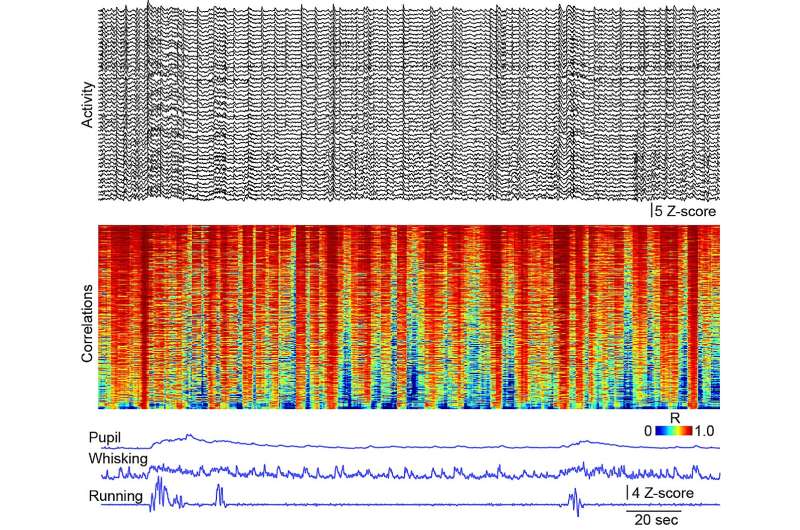December 20, 2023 feature
This article has been reviewed according to Science X's editorial process and policies. Editors have highlighted the following attributes while ensuring the content's credibility:
fact-checked
peer-reviewed publication
trusted source
proofread
New insight on how neural dynamics vary during spontaneous behavior

Past studies have consistently linked the spontaneous behaviors of mammals to variations in the activity of neurons within the cerebral cortex, the outer layer of the mammalian brain. However, the complex relationships between patterns of cortical activity and behavior have remained poorly understood.
Researchers at Yale University and the University of California San Diego recently carried out new experiments on mice aimed at exploring these links further. Their paper, published in Nature Neuroscience, provides new insight into how neurons in the mouse cortex represent behavioral information.
"Our lab has been developing approaches to image the activity across the cortex of awake, behaving mice for several years now," Michael J. Higley, principal investigator of the team that carried out the study, told Medical Xpress. "These complex data sets present some profound challenges to analyzing and interpreting their relationship to behavior. Through a collaboration with Ronald Coifman in the Yale Mathematics Department, postdoctoral fellow Hadas Benisty used her expertise in mathematics and signal processing to look at our imaging data in new ways."
The primary objective of the recent study by Higley and his colleagues was to identify aspects of the neural signals associated with spontaneous behavior that are most closely linked to changes in the animal's behavior in real-time. To do this, they used optical imaging techniques that allow neuroscientists to closely examine the activity of specific cell types while animals are awake and engaged in various activities.
"Normally, we divide the brain into several different areas and measure how activity goes up and down over time in each region," Higley said. "Previous studies (including from our own lab) examined how these up-and-down fluctuations occurred during measured changes in the animal's behavior (such as running on a wheel). Here, we also looked at how correlations between 'pairs' of areas varied over time."
Higley and his colleagues found that these correlations in neural activity between cortical areas, often broadly known as functional connectivity, tend to vary rapidly over time. This means that, for instance, the similarity between the activity in one area and another could be high and then become low in a few hundred milliseconds.
"We also observed, for the first time, that these rapid changes in correlations were also strongly coupled to fast variation in the animal's behavior," Higley said. "Individual brain cells (neurons) are most strongly activated upon receiving synchronized (correlated) inputs from many different regions. Thus, temporal variation in such correlations suggests a distinct way in which single cells might be modulated by behavior."
The recent study by Highly and his colleagues provides a new way of understanding how neural dynamics vary in alignment with spontaneous animal behavior. Specifically, it suggests that individual cells might be more activated at times in which the inputs they receive are correlated with each other, not simply when those inputs are strong.
In their next studies, the researchers plan to continue exploring the complex connections between functional connectivity patterns and spontaneous animal behavior. Firstly, they plan to try to identify causal links between neural activity and behavior using advanced research methods, such as optogenetic techniques.
"Using optogenetics, we can briefly perturb activity or correlations in targeted areas and explore whether this manipulation alters the animal's behavior," Higley added.
"We would also like to extend our analyses to more complicated behaviors, such as mice actively navigating an environment to search for a reward. Finally, we are investigating the relationship between patterned activity and behavior in genetic models of neurodevelopmental disorders such as autism, to try and understand how genetic perturbation might ultimately lead to disruptions in behavior."
More information: Rapid fluctuations in functional connectivity of cortical networks encode spontaneous behavior. Nature Neuroscience(2023). DOI: 10.1038/s41593-023-01498-y.
© 2023 Science X Network




















